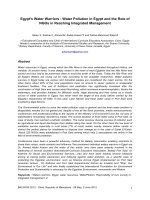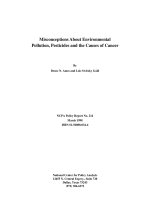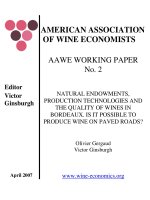hancock - plant evolution and the origin of crop species 2e (cabi, 2004)
Bạn đang xem bản rút gọn của tài liệu. Xem và tải ngay bản đầy đủ của tài liệu tại đây (3.1 MB, 324 trang )
PLANT EVOLUTION AND THE ORIGIN OF
CROP SPECIES
Plant Evolution and the Origin of
Crop Species
Second Edition
James F. Hancock
Department of Horticulture
Michigan State University
CABI Publishing
CABI Publishing is a division of CAB International
CABI Publishing
CAB International
Wallingford
Oxon OX10 8DE
UK
Tel: +44 (0)1491 832111
Fax: +44 (0)1491 833508
E-mail:
Website: www.cabi-publishing.org
CABI Publishing
875 Massachusetts Avenue
7th Floor
Cambridge, MA 02139
USA
Tel: +1 617 395 4056
Fax: +1 617 354 6875
E-mail:
©J.F Hancock 2004. All rights reserved. No part of this publication may be reproduced
.
in any form or by any means, electronically, mechanically, by photocopying, recording
or otherwise, without the prior permission of the copyright owners.
A catalogue record for this book is available from the British Library, London, UK.
Library of Congress Cataloging-in-Publication Data
Hancock, James F.
Plant evolution and the origin of crop species / James F. Hancock.-2nd ed.
p. cm.
Includes bibliographical references (p.
).
ISBN 0-85199-685-X (alk. paper)
1. Crops--Evolution. 2. Crops--Origin. 3. Plants--Evolution. I.
Title.
SB106.O74H36 2003
633-dc21
2003006924
ISBN 0 85199 685 X
Artwork provided by Marlene Cameron.
Typeset in 10pt Souvenir by Columns Design Ltd, Reading.
Printed and bound in the UK by Biddles Ltd, Guildford and King’s Lynn.
Contents
Preface
Acknowledgements
ix
ix
Introduction
1
Part 1. Evolutionary Processes
1. Chromosome Structure and Genetic Variability
Gene and Chromosomal Structure
Types of Mutation
Measurement of Variability
Construction of Genetic Maps and Genome Evolution
3
4
5
16
28
2. Assortment of Genetic Variability
Random Mating and Hardy–Weinberg Equilibrium
Migration
Selection
Genetic Drift
Evolution in Organelles
Interaction between Forces
32
32
35
42
52
54
55
3. The Multifactorial Genome
Intragenomic Interactions
Coadaptation
Canalization
Paradox of Coadaptation
58
60
64
72
73
4. Polyploidy and Gene Duplication
Factors Enhancing the Establishment of Polyploids
77
78
v
vi
Contents
Evolutionary Advantages of Polyploidy
Genetic Differentiation in Polyploids
Chromosomal Repatterning
Genome Amplification and Chance
5. Speciation
What is a Species?
Reproductive Isolating Barriers
Modes of Speciation
Genetic Differentiation during Speciation
Hybridization and Introgression
Hybridization and Extinction
Crop–Weed Hybridizations
Risk of Transgene Escape into the Environment
80
93
95
98
100
100
103
110
117
119
124
125
127
Part 2. Agricultural Origins and Crop Evolution
6. The Origins of Agriculture
Rise of our Food Crops
Emergence of Homo
Evolution of Homo
Appearance of Modern Humans
Spread of H. sapiens
Agricultural Origins
Early Crop Dispersals
Transcontinental Crop Distributions
129
129
131
137
139
141
143
145
148
7. The Dynamics of Plant Domestication
Evolution of Farming
Early Stages of Plant Domestication
Origins of Crops
Characteristics of Early Domesticants
Changes During the Domestication Process
Genetic Regulation of Domestication Syndromes
Evolution of Weeds
Genetic Diversity and Domestication
Domestication and Native Diversity Patterns
151
153
154
157
159
161
163
166
169
170
8. Cereal Grains
Barley
Maize
Millets
Oats
Rice
Rye
Sorghum
Wheat
174
174
176
181
183
185
187
188
190
Contents
vii
9. Protein Plants
Chickpea
Cowpea
Pea
Lentil
Phaseolus Beans
Faba Beans
Soybean
195
195
196
198
200
203
206
206
10. Starchy Staples and Sugars
Banana
Cassava
Potato
Sugar Cane
Sugar Beet
Sweet Potato
Taro
Yam
209
209
212
214
217
219
220
222
223
11. Fruits, Vegetables, Oils and Fibres
Fruits
Apples
Citrus
Grape
Peach
Strawberry
Vegetables
Cole Crops
Squash and Gourds
Chilli Peppers
Tomato
Fibres and Oils
Cotton
Groundnut
Sunflower
226
12. Postscript: Germ-plasm Resources
Ex situ Conservation
In situ Conservation
246
248
249
References
251
Index
307
226
228
230
231
232
234
236
238
240
241
243
244
Preface
The first edition of this book was published in 1992 by Prentice-Hall. This
second edition incorporates the wealth of new information that has emerged
over the last decade on plant evolution. The advent of molecular markers has
generated a cascade of new information on evolutionary processes, the structure of plant genomes and crop origins. Ideas about the evolutionary role of
introgression, hybridization and polyploidy have been dramatically altered,
and the species origins of many recalcitrant crops have been elucidated. In
addition, the major loci associated with domestication have been mapped
and it has been shown that crop genomes can be quite fluid. To my knowledge, no other book on plant evolution has attempted to combine the last
decade of molecular information with conventionally acquired information.
In this edition, I have tried very hard to show how natural and crop evolution are intimately associated. Much more of the crop information is incorporated in the early evolutionary discussions, and I take greater pains to
describe the evolutionary mechanisms associated with crop domestication.
The previous discussion about prehuman plant and animal evolution has
been greatly abbreviated so that more space can be devoted to variation
patterns associated with crop domestication and dispersal. All in all, I think
this edition does a better job of describing the continuum between natural
and crop evolution.
Acknowledgements
Numerous people contributed directly and indirectly to the book: first and
foremost, my wife, Ann, who has been unflagging in her support over the
ix
x
Preface
years and has served as a model of creativity and drive. Marlene Cameron
added greatly to the text with her exceptional artwork. Norm Ellstrand and
Paul Gepts made numerous helpful suggestions. I am also indebted to the
students who have pushed me in my crop evolution class over the last 20
years, and the Plant Breeding and Genetics Journal Club, which keeps
uncovering important publications that I have missed.
Several previous texts have had particularly strong influences on me
and been tremendous resources: J.R. Harlan’s Crops and Man, C.B. Heiser’s
Seed to Civilization, V. Grant’s Plant Speciation and Organismic Evolution,
J.D. Sauer’s Historical Geography of Crop Plants: a Select Roster, J. Smartt
and N.W. Simmond’s Evolution of Crop Plants, B. Smith’s The Emergence
of Agriculture, and D. Zohary and M. Hopf ’s Domestication of Plants in the
Old World.
Introduction
This book has been written for advanced undergraduates and graduate students in the biological sciences. It is meant primarily as a text for crop evolution courses, but should serve well in a wide range of plant evolution and
systematics courses. It is also intended as a resource book on individual crop
histories. I have worked hard to combine the recently emerging molecular
data with archaeological, morphological and cytogenetic information.
The book is arranged in two sections: Chapters 1–5 cover the genetic
mechanisms associated with plant evolution, and Chapters 6–12 deal with
the domestication process and the origin of crop species. In the first half of
the book, little effort is made to distinguish between natural and crop evolution, since both kinds of change occur through the reorganization of genetic
variability. The processes of change are the same, regardless of whether we
are dealing with wild or domesticated populations; only the selector differs.
In the first five chapters, I rely heavily on the evolutionary literature, but try
to incorporate relevant crop species where appropriate. The goal of these
chapters is to describe the overall framework of species change and demonstrate the intimacy of nature and crop evolution.
In the second half of the book, I focus on when and where crops were
domesticated and the types of changes associated with their domestication.
Chapters 6 and 7 give an overview of the emergence and diffusion of agriculture, and the ways species were changed during domestication. The next
four chapters deal with the evolution of individual crops, representing grains,
legumes, starchy roots, fruits, vegetables and oils. Whenever possible, the
genetic mechanisms described in the first five chapters are highlighted. The
last chapter contains a brief discussion of germ-plasm resources and why
they need to be maintained. Clearly, if we are to continue to feed the human
© J. Hancock 2004. Plant Evolution and the Origin of Crop Species,
2nd edn (J.F. Hancock)
1
2
Introduction
population, we must develop greater respect for our natural populations and
their ongoing evolution.
The overall goal of this book is to describe the processes of evolution in
native and cultivated populations and to provide a blueprint for the systematic study of crop origins. It is hoped that when the student completes this
book she or he will understand the factors involved in species change and will
have a greater appreciation of the coadaptive nature of plants and people.
Chromosome Structure and
Genetic Variability
1
Introduction
Evolution is the force that shapes our living world. Countless different
kinds of plants and animals pack the earth and each species is itself composed of a wide range of morphologies and adaptations. These species
are continually being modified as they face the realities of their particular
environments.
In its simplest sense, evolution can be defined as a change in gene
frequency over time. Genetic variability is produced by mutation and
then that variability is shuffled and sorted by the various evolutionary
forces. It does not matter whether the species are cultivated or wild, the
basic evolutionary processes are the same. The way in which organisms
evolve is dependent on their genetic characteristics and the type of environment they must face.
A broad spectrum of evolutionary forces act to alter species including
migration, selection and random chance. In the next four chapters, we
shall describe these parameters and how they interact; but, before we do
this, we shall begin by discussing the different types of genetic variability
that are found in plants. The primary requirement for evolutionary change
is genetic variability and mutation generates these building-blocks. A wide
range of mutations can occur at all levels of genetic organization from
nucleotide sequence to chromosome structure. In this chapter, we shall discuss how plant genes are organized in chromosomes and then the kinds of
genetic variability present and their measurement.
© J.F. Hancock 2004. Plant Evolution and the Origin of Crop Species,
2nd edn (J.F. Hancock)
3
4
Chapter 1
Gene and Chromosomal Structure
Both gene and chromosome structure is complex. Genes are composed of
coding regions, called exons, and non-coding regions, called introns. Both
the introns and exons are transcribed, but the introns are removed from the
final RNA product before translation (Fig. 1.1). There are also short DNA
sequences both near and far from the coding region that regulate transcription, but are not transcribed themselves. Promoter sequences are found
immediately before the protein coding region and play a role in the initiation
of transcription, while enhancer sequences are often located far from the
coding region and regulate levels of transcription.
Each chromosome contains not only genes and regulatory sequences, but
also a large amount of short, repetitive sequences. Some of these are concentrated near centromeres in the densely stained portions of chromosomes called
heterochromatic regions, and may play a role in the homologous pairing of
chromosomes and their separation. However, there are numerous other
repeating units that are more freely dispersed over chromosomes and do not
appear to have a functional role. These have been described by some as ‘selfish’ or ‘parasitic’ as their presence may stimulate further accumulation of similar sequences through transposition, a topic we shall discuss more fully later
(Doolittle and Sapienza, 1980; Orgel and Crick, 1980).
The overall amount of DNA in nuclei can vary dramatically between
taxonomic groups and even within species. The total DNA content of nuclei
is commonly referred to as the genome. There is a 100-fold variation in
genome size among all diploid angiosperms, and congeneric species vary
commonly by threefold (Price et al., 1986; Price, 1988). In some cases,
genomic amplification occurs in a breeding population in response to environmental or developmental perturbations (Walbot and Cullis, 1985; Cullis,
1987). Most of these differences occur in the quantity of repetitive DNA and
not unique sequences.
Except in the very small genome of Arabidopsis thaliana (Barakat et al.,
1998), it appears that genes are generally found near the ends of chromosomes in clusters between various kinds of repeated sequences (Schmidt
and Heslop-Harrison, 1998; Heslop-Harrison, 2000). The amount of inter-
Fig. 1.1. Organization of a typical eucaryotic gene. A precursor RNA molecule is
produced from which the introns are excised and the exons are spliced together
before translation. The CAAT and TATA boxes play a role in transcription initiation
and enhancement.
Chromosome Structure and Genetic Variability
5
spersed repetitive DNAs can be considerable, making the physical distances
between similar loci highly variable across species. However, the gene clusters may be ‘hot spots’ for recombination, making recombination-based
genetic lengths much closer than physical distances (Dooner and MartinezFerez, 1997; Schmidt and Heslop-Harrison, 1998).
Types of Mutation
There are four major types of mutation: (i) point mutations; (ii) chromosomal sequence alterations; (iii) chromosomal additions and deletions; and
(iv) chromosomal number changes. Point mutations arise when nucleotides
are altered or substituted. For example, the base sequence CTT becomes
GTT. Chromosomal sequence alterations occur when the order of
nucleotides is changed within a chromosome. Chromosomal duplications
and deletions are produced when portions of chromosomes are added or
subtracted. Chromosomal numerical changes arise when the number of
chromosomes changes.
Point mutations
Nucleotide changes occur spontaneously due to errors in replication and
repair at an average rate of 1 × 10Ϫ6 to 10Ϫ7. These estimates have come
largely from unicellular organisms, such as bacteria and yeast, which are
easy to manipulate and have tremendous population sizes, but good estimates have also been obtained in higher plants using enzymes (Kahler et al.,
1984) and a variety of seed traits (Table 1.1). Mutation rates can be
increased by numerous environmental agents, such as ionizing radiation,
chemical mutagens and thermal shock.
Table 1.1. Spontaneous mutation rates of several endosperm
genes in Zea mays (from Stadler, 1942).
Gene
Character
R
I
Pr
Su
C
Y
Sh
Wx
Aleurone colour
Colour inhibitor
Purple colour
Sugary endosperm
Aleurone colour
Yellow seeds
Shrunken seeds
Waxy starch
No. of gametes
tested
Mutation
rate
554,786
265,391
647,102
1,678,736
426,923
1,745,280
2,469,285
1,503,744
0.00049
0.00011
0.000011
0.000002
0.000002
0.000002
0.000001
< 0.000001
6
Chapter 1
Sequence alterations
Three types of DNA sequence alterations occur: translocations, inversions
and transpositions. Small numbers of redundant nucleotide blocks may
be involved or whole groups of genes. Translocations occur when
nucleotide sequences are transferred from one chromosome to another.
In homozygous individuals, nuclear translocations have no effect on fertility, but in heterozygous individuals only a portion of the gametes are
viable, due to duplications and deficiencies (Fig. 1.2). Translocations are
widespread in a number of plant genera, including Arachis, Brassica,
Campanula, Capsicum, Clarkia, Crepis, Datura, Elymus, Galeopsis, Gilia,
Gossypium, Hordeum, Layia, Madia, Nicotiana, Paeonia, Secale, Trillium
and Triticum (Grant, 1975; Holsinger and Ellstrand, 1984; Konishi and
Linde-Laursen, 1988; Stalker et al., 1991; Livingstone et al., 1999).
Populations are generally fixed for one chromosomal type, but not
all. Translocation heterozygotes are common in Paeonia brownii (Grant,
1975), Chrysanthemum carinatum (Rana and Jain, 1965), Isotoma
petraea (James, 1965) and numerous species of Clarkia (Snow, 1960).
Probably the most extreme example of translocation heterozygosity is in
Oenothera biennis, where all of its nuclear chromosomes contain translocations and a complete ring of chromosomes is formed at meiosis in heterozygous individuals (Cleland, 1972). In some cases, translocations have
resulted in the fusion and fission of non-homologous chromosomes with
short arms (Robertsonian translocations).
Inversions result when blocks of nucleotides rotate 180°. Nuclear
inversions are called pericentric when the rotation includes the centromere and paracentric when the centromeric region remains unaffected
(Figs 1.3 and 1.4). As with translocations, individuals that are heterozygous produce numerous unviable gametes but only if there is a crossover
between chromatids; all the gametes of homozygotes are fertile regardless
of crossovers.
Inversion polymorphisms have been described in a number of plant
genera. One of the best documented cases of an inversion heterozygosity
within a species is in Paeonia californica, where heterozygous plants are
common throughout the northern range of the species (Walters, 1952).
As we shall describe more fully in the chapter on speciation (Chapter 5),
inversions on six chromosomes distinguish Helianthus annuus, Helianthus
petiolaris and their hybrid derivative Helianthus anomalus (Rieseberg et
al., 1995). Tomato and potato vary by five inversions (Tanksley et al.,
1992), and pepper and tomato by 12 inversions (Livingstone et al.,
1999). The chloroplast genome of most angiosperm species has a large
inverted repeat (Fig. 1.5), but its structure is highly conserved across families. Only a few species do not have the repeat and no intrapopulational
variation has been described (Palmer, 1985).
Chromosome Structure and Genetic Variability
7
Fig. 1.2. Types of gametes produced by a plant heterozygous for a translocation. A
ring of chromosomes is formed at meiosis and depending on how the chromosomes
orient at metaphase and separate during anaphase, viable or unviable combinations
of genes are produced. (Used with permission from T. Dobzhansky, © 1970,
Genetics of the Evolutionary Process, Columbia University Press, New York.)
Transposition occurs when nucleotide blocks move from place to
place in the genome (McClintock 1953, 1956; Bennetzen, 2000a;
Fedoroff, 2000). There are two major classes of transposons: DNA and
RNA transposable elements. The RNA transposable elements (retroelements) amplify via RNA intermediates, while the DNA transposons rely
8
Chapter 1
Fig. 1.3. Chromosome types produced after crossing over in an individual
heterozygous for a pericentric inversion. Note the two abnormal chromatids, one
with a duplication and the other with a deficiency. (Used with permission from
T. Dobzhansky, © 1970, Genetics of the Evolutionary Process, Columbia University
Press, New York.)
on actual excision and reinsertion. Both classes of transposition have
been found in all plant species where detailed genetic analysis has been
performed, and in many plant species, mobile elements actually make up
the majority of the nuclear genome (SanMiguel and Bennetzen, 1998;
Bennetzen, 2000a). Most of the transposons are inserted into non-coding
regions, but sometimes they enter exons and, when they do, they can
have extreme effects on phenotype. The wrinkled-seed character
described by Mendel is caused by a transpose-like insertion into the gene
encoding a starch-branching enzyme (Bhattacharyya et al., 1990). Much
of the flower colour variation observed in the morning glory is due to the
insertion and deletion of transposable elements (Clegg and Durbin, 2000;
Durbin et al., 2001).
Chromosome Structure and Genetic Variability
9
Fig. 1.4. Chromosome types produced after crossing over in an individual
heterozygous for a paracentric inversion. Note the chromosomal bridge and the
resulting chromatids with deletions. (Used with permission from T. Dobzhansky,
© 1970, Genetics of the Evolutionary Process, Columbia University Press, New York.)
The DNA transposons range in size from a few hundred bases to 10 kb,
and the most complex members are capable of autonomous excision, reattachment and alteration of gene expression. They all have short terminal inverted
repeats (TIRs); the most complex ones encode an enzyme called transposase
that recognizes the family’s TIR and performs the excision and reattachment.
Retroelements (RNA transposons) are the most abundant class of transposons and they make up the majority of most large plant genomes. They transpose through reverse transcription of RNA intermediates, and as a result they do
not excise when they transpose, resulting in amplification. The most abundant
10
Chapter 1
atp B
rbc L
pet A
psb E
psb B
pet B
pet D
rpoA
rps 11
inf A
rps19
rpl 2
rps 7
rps 12
16S
23S
atp E
psaA psaB
psbC
psbD
atpI
atpH
atpF
atpA
psbA
rpl 2
rps 7
rps 12
16S
23S
Fig. 1.5. The gene map of spinach chloroplast DNA. The two long thickenings in the
lower half of the circle represent the inverted repeat. Gene designations: rbcL, the large
subunit of ribulose bisphosphate carboxylase; atpA, atpB, atpE, atpF, atpH and atpI, the
alpha, beta, epsilon, CF0-I, CF0-III and CF0-IV subunits of chloroplast coupling factor,
respectively; psaA and psaB, the P700 chlorophyll-a apoproteins of photosystem I;
psbA, psbB, psbC, psbD and psbE, the Q-beta (32 kilodaltons (kDa), herbicidebinding), 51 kDa chlorophyll-a-binding, 44 kDa chlorophyll-a-binding, D2 and
cytochrome-b-559 components of photosystem II; petA, petB and petD, the genes for
the cytochrome-f, cytochrome-b6 and subunit-4 components of the cytochrome-b6-f
complex; infA, initiation factor IF-1; rpoA, alpha subunit of RNA polymerase; rpl2, rps7,
rps11, rps12, and rps19, the chloroplast ribosomal proteins homologous to Escherichia
coli ribosomal proteins L2, S7, S11, S12 and S19, respectively; 16S and 23S, the 16S
and 23S ribosomal RNAs, respectively. (Used with permission from J.D. Palmer,
© 1987, American Naturalist 130, S6–S29, University of Chicago Press, Chicago.)
class of retroelements in plants are the LTR (long terminal repeat) retrotransposons, varying in size from a few hundred to over 10,000 nucleotides.
Duplications and deficiencies
Chromosomal deficiencies occur when nucleotide blocks are lost from within
a chromosome, while duplications arise when nucleotide sequences are multiplied. These are caused by unequal crossing over at meiosis or translocation (Burnham, 1962). They can also occur when DNA strands mispair
during replication of previously duplicated sequences (Levinson and
Gutman, 1987). As previously mentioned, the genome is filled with high
numbers of short, repeated sequences that vary greatly in length – so greatly,
in fact, that some of them, such as single sequence repeats (SSRs), have
proved valuable as molecular markers to distinguish species, populations
and even individuals. Variations in gene copy number have been found in a
Chromosome Structure and Genetic Variability
11
very wide array of crop species. Gene amplifications are so common that
Wendel (2000) has suggested that ‘one generalization that has been confirmed and extended by the data emerging from the global thrust in genome
sequencing and mapping is that most “single-copy” genes belong to larger
gene families, even in putatively diploid organisms’. Using sequence data,
the fraction of the genome represented by duplications has been estimated
to be 72% in maize (Ahn and Tanksley, 1993; Gaut and Doebley, 1997) and
60% in A. thaliana (Blanc et al., 2000).
Clusters of duplicated genes are often found scattered at multiple locations across the genome. When Blanc et al. (2000) compared the sequence
of duplications on chromosomes 2 and 4 of A. thaliana, they identified 151
pairs of genes, of which 59 (39%) showed highly similar nucleotide
sequences. The order of these genes was generally maintained on the two
chromosomes, except for a small duplication and an inversion. When they
compared the sequence of these duplicated regions to the rest of the genome,
they found 70% of the genes to be present elsewhere. The genes were duplicated in 18 large translocations and several smaller ones (Fig. 1.6).
Fig. 1.6. Locations of duplications throughout the Arabidopsis genome. Similar
blocks on different chromosomes are identified by similar coloured regions and
arrows. (Modified from Blanc et al., 2000.)
12
Chapter 1
Chromosomal numerical changes
There are three primary types of numerical changes found in nuclear
genomes: (i) aneuploidy; (ii) haploidy; and (iii) polyploidy. In aneuploidy,
one or more chromosomes of the normal set are absent or present in excess.
Haploids have half the normal chromosome set, while polyploids have more
than two sets of homologous chromosomes.
Haploids are quite rare in nature, although they have been produced
experimentally in many crops, including strawberries, lucerne and maize.
They are generally unviable due to meiotic irregularities and low in vigour
because lethal alleles are not buffered by heterozygosity.
Aneuploids are more common than haploids, although they are still relatively rare in natural populations. Most base numbers differ by a few chromosomes (Citrus, Rubus, Poa, Nicotiana, Gossypium, Allium and
Lycopersicon), but extensive variations involving dozens of chromosomes
occur in some groups (Abelmoschus and Saccharum). Aneuploids arise
through the fusion and fission of chromosomes and when chromosomes
migrate irregularly during meiosis. They are most common in polyploid
species and hybrid populations resulting from trans-specific crosses.
Polyploidy is quite prevalent in higher plants; between 35 and 50% of all
angiosperm species are polyploid (Grant, 1971). The number of polyploid
crop species is even higher (78%) (Table 1.2) if we use the widely accepted
assumption that chromosome numbers above 2n = 18 represent polyploids.
This is a conservative estimate, as many groups are thought to have haploid
numbers lower than x = 9 (Grant, 1963). Most polyploids are thought to originate through the unification of unreduced gametes (Harlan and deWet, 1975;
Bretagnolle and Thompson, 1995). Only occasionally do polyploids arise
through somatic doubling and the generation of polyploid meristems, called
‘sports’. Most commonly this is done artificially with the chemical colchicine.
Aneuploidy and polyploidy can have rather extreme effects on the physiology and morphology of individuals, since gene dosages are doubled. Cell
sizes usually increase, developmental rates slow down and fertility is often
reduced. The whole of Chapter 4 is devoted to the physiological and evolutionary ramifications of polyploidy.
There are two major types of polyploids: autopolyploids and allopolyploids (amphiploids) (Fig. 1.7). Allopolyploids are derived from two different ancestral species, whose chromosome sets cannot pair at meiosis. As a
result, the chromosomes segregate and assort as in diploids, so inheritance
of each individual duplicated loci of allopolyploids follows typical
Mendelian patterns. In other words, allopolyploids display ‘disomic inheritance’, where two alleles segregate at a locus. The chromosome sets of
autopolyploids are derived from a single or closely related ancestral
species and they can pair at meiosis. The chromosomes associate together
either as multivalents or random associations of bivalents. As a result,
Chromosome Structure and Genetic Variability
13
Table 1.2. Chromosome numbers in selected crop species.
Diploids 2n ≤ 18
Allium cepa (onion)
Avena sativa (oat)
Beta vulgaris (sugar beet)
Beta oleracea (kale)
Carica papaya (pawpaw)
Cicer arietinum (chickpea)
Citrus spp. (citrus)
Cucumis sativus (cucumber)
Daucus carota (carrot)
Hordeum vulgare (barley)
Lactuca sativa (lettuce)
Lens culinaris (lentil)
Pennisetum americanum
(pearl millet)
Pisum sativum (pea)
Prunus amygdalus (almond)
Prunus armeniaca (apricot)
Prunus avium (sweet cherry)
Prunus persica (peach)
Raphanus sativus (radish)
Ribes nigrum (blackcurrants)
Ribes sativum (redcurrants)
Secale cereale (rye)
Triticum monococcum (einkorn)
Vicia faba (bean)
Polyploids 2n > 18
16
14
18
18
18
16
18
14
18
14
18
14
14
14
16
16
16
16
18
16
16
14
14
12
Abelmoschus esculentus (okra)
33–72
Aleurites fordii (tung)
22
Ananas comosus (pineapple)
50
Arachis hypogaea (groundnut)
40
Artocarpus altilis (breadfruit)
56, 84
Avena abyssinica (oat)
28
Avena nuda (oat)
42
Avena sativa (oat)
42
Brassica campestris (turnip)
20
Brassica napus (rape)
38
Cajanus cajan (pigeon-pea)
22
Camellia sinensis (tea)
30
Cannabis sativa (hemp)
20
Capsicum spp. (peppers)
24
Carthamus tinctorius (safflower)
24
Chenopodium quinoa (quinoa)
36
Citrullus lanatus (water melon)
22
Cocos nucifera (coconut)
32
Coffee arabica (coffee)
44
Colocasia esculenta (taro)
28
Cucumis melo (musk melon)
24
Cucurbita spp. (squash)
20
Dioscorea alata (yam)
30, 40, 50, 60, 70, 80
Dioscorea esculenta (yam)
40
Dioscorea rotundata (yam)
40
Elaeis guineensis (oil palm)
32
Eleusine coracana (finger millet)
36
Ficus carica (fig)
26
Fragaria ϫ ananassa (strawberry)
56
Glycine max (soybean)
40
Gossypium arboreum (cotton)
26
Gossypium barbadense (cotton)
26
Gossypium herbaceum (cotton)
52
Gossypium hirsutum (cotton)
52
Helianthus annuus (sunflower)
34
Helianthus tuberosus (Jerusalem artichoke) 102
Hevea brasiliensis (rubber)
36
Ipomoea batatas (sweet potato)
90
Linum usitatissimum (linseed)
30, 32
Lycopersicon esculentum (tomato)
24
Malus ϫ domestica (apple)
34, 51
Mangifera indica (mango)
40
Manihot esculenta (cassava)
36
Medicago sativa (lucerne)
Musa spp. (bananas)
22, 33, 44
Nicotiana tabacum (tobacco)
48
Olea europaea (olive)
46
Oryza sativa (rice)
24
Oryza globerrima (rice)
24
Continued
14
Chapter 1
Table 1.2. Continued.
Diploids 2n ≤ 18
Polyploids 2n > 18
Persea americana (avocado)
24
Phaseolus acutifolius (tepary bean)
22
Phaseolus coccineus (runner bean)
22
Phaseolus lunatus (lima bean)
22
Phaseolus vulgaris (common bean)
22
Phoenix dactylifera (date)
36
Piper nigrum (pepper)
48, 52, 104, 128
Prunus cerasus (sour cherry)
32
Pyrus spp. (pears)
34,51
Ricinus comminis (castor)
20
Saccharum spp. (sugar cane)
60–205
Sesamum indicum (sesame)
26
Solanum melongena (aubergine)
24
Solanum tuberosum (potato)
24, 36, 48, 60
Sorghum bicolor (sorghum)
20
Triticum aestivum (bread wheat)
42
Triticum timopheevii (wheat)
28
Triticum turgidum (emmer)
28
Vaccinium corymbosum (blueberry)
48
Vigna unguiculata (cowpea)
22
Vitis spp. (grape)
40
Zea mays (maize)
20
inheritance in autopolyploids does not follow typical Mendelian patterns,
since the chromosomes carrying the duplicated loci can pair.
Autopolyploids have more than two alleles at a locus and display what is
called ‘polysomic inheritance’.
The two major types of polyploids can be further divided into the following groups (Grant, 1971):
I.
Autopolyploids
1. Strict autopolyploids (one progenitor, polysomic inheritance).
2. Interracial autopolyploids (closely related progenitors, polysomic
inheritance).
II. Amphiploids
1. Segmental allopolyploids (partially divergent progenitors, mixed
inheritance).
2. Genomic allopolyploids (divergent progenitors, disomic inheritance).
3. Autoallopolyploids (complex hybrid of related and divergent
progenitors).
Strict autopolyploids are based on the doubling of one individual, while
interracial autopolyploids arise after the hybridization of distinct individuals
within the same or closely related species. They form multivalents at meiosis
or there is a random association of homologues into bivalents, resulting in
polysomic inheritance. The simplest case is tetrasomic inheritance (four alleles









